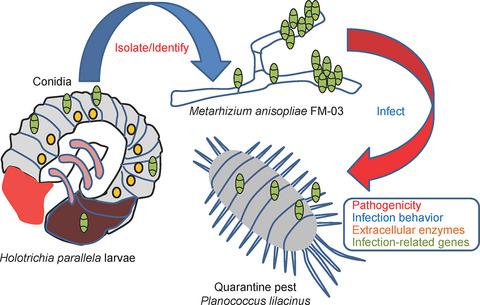当前位置:
X-MOL 学术
›
Entomol. Exp. Appl.
›
论文详情
Our official English website, www.x-mol.net, welcomes your
feedback! (Note: you will need to create a separate account there.)
Pathogenic characteristics and infection‐related genes of Metarhizium anisopliae FM‐03 infecting Planococcus lilacinus
Entomologia Experimentalis et Applicata ( IF 1.4 ) Pub Date : 2021-02-16 , DOI: 10.1111/eea.13036 Peng Huang 1 , Jinai Yao 1 , Yongwen Lin 2 , Deyi Yu 1
Entomologia Experimentalis et Applicata ( IF 1.4 ) Pub Date : 2021-02-16 , DOI: 10.1111/eea.13036 Peng Huang 1 , Jinai Yao 1 , Yongwen Lin 2 , Deyi Yu 1
Affiliation

|
Planococcus lilacinus (Cockerell) (Hemiptera: Pseudococcidae) is a global flower and fruit pest, and a severe infestation is currently seen in the sugar apple (Annona squamosa L., Annonaceae) orchards of Zhangzhou, Fujian Province, China. Biological control with entomopathogenic fungi is safe, effective, and long‐lasting, and has potential for the control of mealybugs. In this study, we analyzed the pathogenic characteristics and infection‐related genes of Metarhizium anisopliae (Metschn.) Sorokīn FM‐03, a strain discovered in the sugar apple orchards, against P. lilacinus, to evaluate its biocontrol potential and application prospects against mealybugs. The results showed that M. anisopliae FM‐03 was highly pathogenic against P. lilacinus. At 10 days after infection, the median lethal concentration (LC50) of strain FM‐03 was 1.45 × 105 spores ml−1 and the cumulative corrected mortality was 93%, whereas the median lethal time (LT50) was 5.27 days for treatment with the highest spore concentration (108 spores ml−1). Planococcus lilacinus was primarily infected from the legs, abdominal segments, and body edges, which are sites with less wax. Infection became clearly visible 72 h post inoculation. Substantial changes occurred in activity of fungal enzymes, with peak values of 26 U ml−1 for proteases and 17 U ml−1 for lipases on day 5 post inoculation to enzyme inducing culture media. The activity of chitinases was relatively stable, with a peak value of 8 U ml−1 on day 6 post inoculation. At 3 days post P. lilacinus infection, a total of 1 069 genes were differentially expressed, of which 137 were annotated as infection‐related. Among the 136 upregulated genes, 10 were identified as potentially crucial for infection regulation. These 10 genes could be targeted for subsequent construction of genetically engineered FM‐03 strains, driving the research and development of effective biocontrol agents for P. lilacinus.
更新日期:2021-04-24











































 京公网安备 11010802027423号
京公网安备 11010802027423号